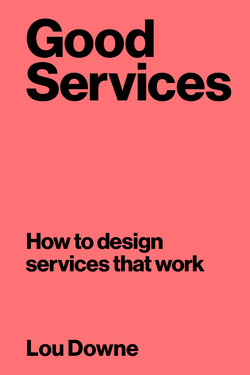Читать книгу Good Services - Lou Downe - Страница 22
На сайте Литреса книга снята с продажи.
ОглавлениеThis is book is called ‘good services’ for a reason. It’s not about ‘great services’, ‘unique services’, ‘thrilling’ or ‘magical’ services.
It won’t tell you how to ‘wow’ your users with something they didn’t expect, or build something that the world has never seen before – that’s the job of user research, which you’ll need to do to find out what they need from your unique service.
What this book will tell you is how to build something that meets the needs of your users, which they can find, understand and use without having to ask for help. It will tell you how to not disappoint your users, and make sure they can do the thing they set out to do. In a nutshell, it will help you to make services that work.
Building a service that works is a sorely undervalued activity of service design. In the rush to create something innovative, both old and new services often forget a user’s most basic needs. Confirmation emails aren’t sent, explanations aren’t clear and appointments aren’t flexible. All of these things lead to a collective friction in our daily lives that far outweighs any ‘magical’ or ‘delightful’ moments we might get from a small handful of services.
So what exactly makes a service ‘good’? Ask most people this question and you will very often get the response of ‘it depends’. But this assumption that all services are completely unique and that there are no similarities between them is wrong.
There are things that we all need from nearly every service we interact with, regardless of what it helps us to do. Things like being able to find that service and use it unaided, regardless of your knowledge or abilities. Or being able to do the thing you set out to do, without having to navigate the bureaucracies created by multiple organisations, or the strange effects of bad staff incentivisation. From luxury hotel check-ins to cancer treatment, from dog grooming to house selling, we need services that work. Services that are findable, usable and benefit our lives and the lives of everyone else around us.
Unlike many other forms of design, though, what makes a good service isn’t a matter of personal taste. A service either works or it doesn’t.
Ask a graphic designer to tell you what makes ‘good’ graphic design and you will get a different answer each time, but at least they’ll give you an answer. That answer will crucially be based on well-known industry-held ideas of best practice that are taught in design schools across the world – things like the grid system, basic principles of typography or use of iconography. Yet despite the fact that what makes a good service isn’t as subjective, service design has traditionally had no such understanding of best practice.
Almost 80% of the UK’s economy is generated from services, a figure closely mirrored by the rest of Europe and North America. The industry of service design (depending on who you ask) is between 15–20 years old and yet, instead of defining what we mean by a good service, we’ve focused on how to design them.
This has led to the creation of a seemingly endless list of books and courses filled with methodologies and diagrams, and no answer to the most basic question: ‘what is a good service?’
Because of this, we spend vast quantities of our time fighting for the legitimacy of service design. After all, how many other professions or activities are unable to answer the question: ‘what does doing your job well look like?’
We need to move beyond this. Not so that we can replace user research or design with standards, but so that we can focus our efforts on learning and responding to the things that are unique about our services, not relearning the things that aren’t.
This book isn’t a to-do list of everything that will make your service work for you and your users – there will be things you will find along the way that are unique to your organisation or service – but it will tell you where to start.
The principles in this book have been crafted from years of experience working on some of the best and worst services in the world and honed by thousands of contributors around the globe who want to answer the question – what does it mean to make a service that works for users?
